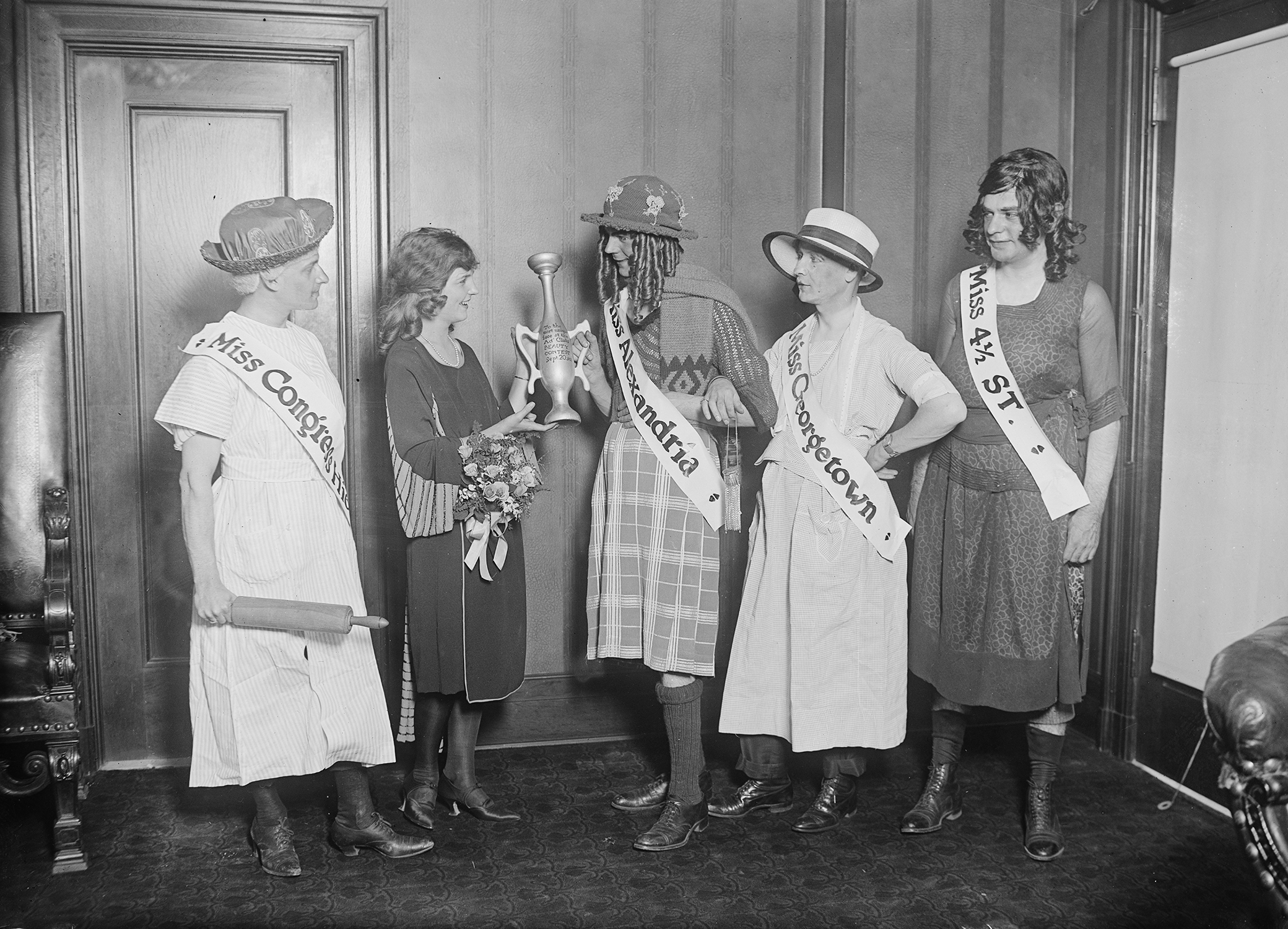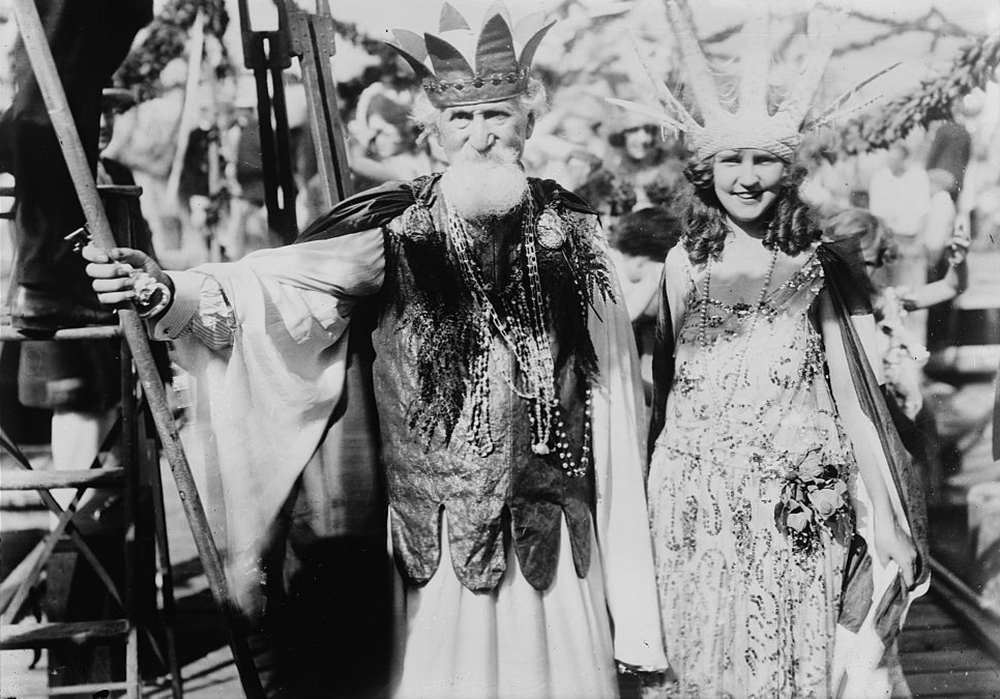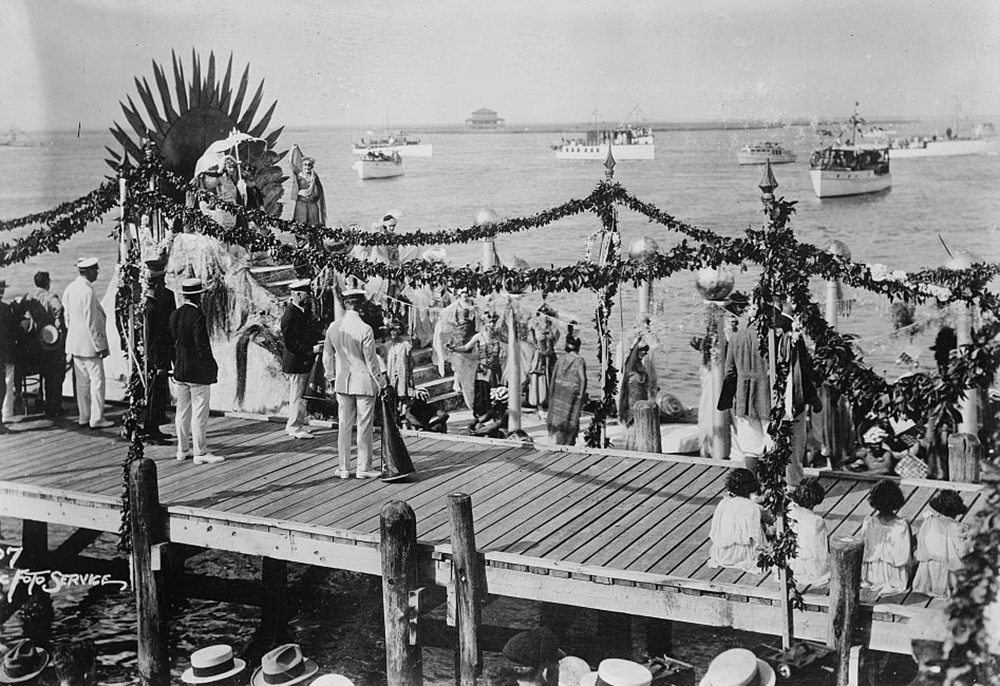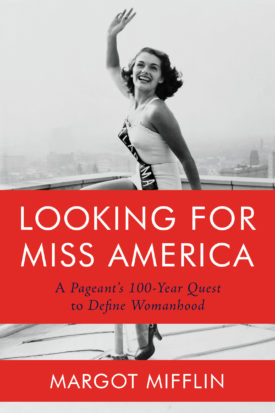
Margaret Gorman presenting the wooden cup to the winner of the Advertising Club’s “beauty” contest, 1921. Photograph by Harris & Ewing. Library of Congress, Prints and Photographs Division.
The 1921 Atlantic City Pageant’s central event kicked off with the rolling chair parade, as hundreds of flower-bedecked floats and chairs rumbled, this time down the boardwalk, the thrumming main artery of the city. The floats advertised businesses, amusements, and civic organizations from the Rotary Club to the Press-Union Company, represented by a nine-foot-long copy of the Atlantic City Daily Press bearing a headline announcing the pageant. The neighboring town of Ventnor’s procession stretched for an entire block, with the mayor leading, flanked by the police and fire departments. The beauties rolled too, flaunting their assets in the hope of winning one of the many prizes to be awarded at the crowning ceremony that evening. Wearing a gold-spangled dress and bronze-tinted shoes, Miss Washington, DC, Margaret Gorman bowed and smiled at hooting fans as children threw flowers in her path.
The sixteen-year-old was already a star, having made a splash that morning in the beachfront Bathers’ Revue, where she and the others marched unsteadily along a 1,300-foot swath of sand roped off and marked with flags. Gorman wore a modest taffeta swimsuit with a tiered skirt and dark knee-high stockings, drawing cheers for her “natty beach rig” and earning points as well, since public enthusiasm counted toward contestants’ final scores. The others sported one- and two-piece suits, a few with skirts hanging to the knee, and one—Miss Pittsburgh—with pants that ended, shockingly, above mid-thigh.
They wore headbands to secure their hair in the wind, belts or scarves tied at the waist, and laced boots, flats, or low heels, posing for photos with feet splayed or even planted six inches apart, in contrast to the “pretty feet” stance prescribed in later years. Likewise, the compulsive smiling that later became a pageant hallmark wasn’t yet reflexive. Photos capture the hopefuls looking variously amused, relaxed, bored, impatient, distracted, or downright stern—charmingly human, and more like the children most of them were than the women they were presumed to be.
And yet something scandalous was happening. The New York Times reported that during the Bathers’ Revue, “the censor ban on bare knees and skintight bathing suits was suspended and thousands of spectators gasped as they applauded the girls, who were judged on their shapeliness and carriage, as well as beauty of face.”
The exposure of bare knees wasn’t just unusual; it was illegal. The city’s 1907 Mackintosh Law prohibited swimwear that ended more than four inches above the knee without stockings rolled up over the thigh to bridge the difference. It was enforced by “beach cops” who trudged around commanding offenders to “Roll ’em up, sister.” (Men, too, were required to cover their chests with tank tops.)
Bathing machines—mobile changing rooms wheeled into the surf to drop women in woolen dresses into the ocean unseen—had been retired at the turn of the century, and swimwear had since replaced streetwear at the beach. But there was still no consensus on appropriate fashion for women who now bathed—and increasingly swam—publicly. In 1907 the woman who invented the one-piece swimsuit, champion swimmer Annette Kellerman, had herself been arrested for indecency for wearing it on Revere Beach in Massachusetts. Designed for speed and intended to be paired with stockings instead of bloomers, it was braless, skirtless, and form-fitting—especially when wet, making it that much easier for this Australian powerhouse to break world records, and that much harder for Victorian holdouts to accept its contours.
Historian Blain Roberts notes the dissonance between regulation and celebration of the swimsuit in this period. “As soon as the smaller swimsuit appeared,” she writes in Pageants, Parlors, and Pretty Women, “beach censors took to the sands to punish women for baring too much skin and the bathing beauty review emerged to reward the very same phenomenon.”
The local press published fiery letters to the mayor about the decision to allow the suits at the Bathers’ Revue. A doctor defended it with the revelation that swimming with stockings is harder than swimming without them. The pageant committee, uncertain about how best to display the newly liberated female body, did what they would do in the face of so many controversies that erupted over the next century: they missed the point entirely. The popular “Annette Kellerman” one-piece—which represented women’s new fashion freedom and even encouraged athleticism—would be tolerated, but only for the length of the pageant, to showcase the beauty of the female form.
That night, Steel Pier’s ballroom was packed with two thousand fans awaiting the announcement of the winner. The ceremony ran long, partly because so many prizes were handed out, but mainly because of Margee Gorman. She won both the amateur Bathers’ Revue and the Inter-City Beauty Contest, the two most important competitions, sending the crowds into such a frenzy of interruptive cheering, even while other prizes were being presented, that the host was repeatedly forced to walk her out and reintroduce her to quiet her fans.

Gorman was voted the most beautiful girl in America. She took home the Golden Mermaid trophy, a gilded mermaid lounging on a teakwood base lined with seashells, and a two-foot-tall silver “beauty urn” donated by Annette Kellerman herself. There was no crown; this winner was a mermaid, not a queen, and she would be named Miss America later, retroactively. The pageant ended in the wee hours, when King Neptune, having delivered his beauty to the Jersey Shore, returned to the sea. Gorman’s entire trip had cost her just thirty-five cents: the price of a collect telegram from a fan that read, “Congratulations. Don’t get stuck up.”
At five feet one, Gorman would stand as the smallest Miss America in the pageant’s history. She was girlish, with slim hips and ringlets, prompting comparisons to silent movie darling Mary Pickford, “America’s Sweetheart.” As the historian Kimberly A. Hamlin writes, the judges “were not interested in celebrating the new, emancipated women of the 1920s, but in promoting images of the girls of yesterday: small, childlike, subservient, and malleable.”
Indeed, Gorman was less significant, in many ways, for what she was than for what she wasn’t. She wasn’t an adult, for starters, so the question of how her sexuality informed her beauty complicated the judging. “She was very attractive for a kid,” said Harry Godshall, a founding board member. Older, worldlier women competed in the less hyped professional category, while lovable ingénues dominated the pageant proper for years to come. They didn’t wear the scarlet lipstick, heavy eyeliner, plucked eyebrows, or boyish bob of the Jazz Age. Gorman was not quite a woman, and she was decidedly not a “New Woman,” by then a popular term for the enfranchised, independent, post-Victorian woman of the modern age. Nor was she a feminist—a term of choice, borrowed from the French feministe, for women whose political concerns transcended the single issue of suffrage. She was not a suffragette, though the sash she wore, bearing her city’s name, suggested otherwise.
The sashes weren’t particular to Miss America (Southern girls had worn state-specific sashes in monument-dedication ceremonies as early as 1908), but they were highly symbolic at that historic moment: suffragettes, for whom pageantry was a powerful vehicle for activism, had worn them in marches beginning with the historic 1913 Woman Suffrage Procession in Washington. The sashes conveyed solidarity with the National Women’s Party through their colors (purple, white, and gold) and their motto, “Votes for Women.” By contrast, the beauty-pageant sashes expressed local affiliation and individual aspiration. This contest was not about women. It was about Woman.
It was also part of a growing reactionary impulse. In the 1920s, as Susan Faludi explains in Backlash: The Undeclared War Against American Women, a counterassault on feminism was already under way: “The media maligned suffragists; magazine writers advised that feminism was ‘destructive of woman’s happiness’; popular novels attacked ‘career women’; clergymen railed against ‘the evils of woman’s revolt’; scholars charged feminism with fueling divorce and infertility; and doctors claimed that birth control was causing ‘an increase in insanity, tuberculosis, Bright’s disease, diabetes, and cancer.’ ” Miss America championed sweet, traditional femininity just when women could see beyond husband-hunting as their only down payment on a future.

The outstanding success of Atlantic City’s first contest hinged on three factors: the terrific growth and class diversity of its resort culture; the relaxation of Victorian fashion restrictions, which led to the acceptance of women’s public swimming; and the birth of the “bathing beauty,” which filmmaker Mack Sennett popularized in his slapstick comedies beginning in 1915.
Sennett claimed to have invented the bathing beauty. So, more legitimately, did Annette Kellerman, who made his films possible by creating the swimsuit in which they cavorted and whose fame as a swimmer led to a successful vaudeville and silent-film career in which her (sometimes fully naked) physique was the focus. Kellerman’s celebration of the “supple body, well groomed and well dressed,” was consonant with the pageant’s; her 1918 book Physical Beauty: How to Keep It offered beauty advice and promoted body positivity—both for women’s own self-esteem and as a means of getting and keeping a husband. (Swimming, she noted, expanded the chest.)
There was also an unspoken motivation for a national beauty competition: eugenics. The momentum of the American eugenics movement of the early twentieth century had inspired Better Baby contests, which applied the principles of evaluating livestock to children and led to Fitter Family contests nationally, the first of which was held at the 1920 Kansas State Fair. Competing clans were graded on their physical and psychological health and—significantly—heredity, in the name of “better breeding” and building larger families as urbanization shrank American farm communities and immigration complexified national identity. Miss America concentrated the focus: what better way to gauge national fitness than through a contest measuring the quality of the breeders themselves—healthy, young unmarried white women? In the early years, contestants were even introduced with recitations of their genealogical history and “breeding,” tracing their pedigree back for generations.
The introduction of the bathing suit into a beauty contest, however, required a delicate dance of decorum that the Miss America pageant never perfected, though it tried for nearly one hundred years. In the 1920s this meant harnessing the physical freedom of the New Woman while shrouding her in Victorian propriety and presenting her as the girl next door. Before bathing beauty contests, the only cultural precedent for the live, public display of seminude women was the burlesque show, from which the pageant borrowed its unison formation and (later) its runway—a feature the famous Minsky brothers added to their burlesque performances in the late 1910s so that as the women moved, howling audiences could “look right up their legs.”
So while women forged ahead in other corners of culture, the pageant held fast to the past, redressing a simmering anxiety about newly empowered women and their impact. Women had worked during World War I, had won the vote, had entered business and politics; by 1921 thirty-three women were serving in state legislatures. The first birth control clinic in the U.S. had opened in Brooklyn in 1916—a huge step for women’s self-determination. A year later, women were admitted as medical students at Columbia University. By 1920 female lawyers could practice in every state.
But women weren’t just seizing opportunities previously denied them. They were also claiming cultural space historically identified with men: Bessie Coleman, bypassing obstacles preventing women and African Americans from getting pilot’s licenses, trained in France and caused a media sensation when she returned with her license to launch a career as a stunt pilot in the 1920s. In 1921 Edith Wharton became the first woman to win a Pulitzer Prize for the Novel—one of five women to claim the award during that decade. Film stars like Clara Bow and Colleen Moore were playing characters who not only enjoyed independence but also expressed erotic desire, as did blues singers such as Ma Rainey and Bessie Smith. As the film historian Gaylyn Studlar writes, in “actively seeking sexual pleasure, American women of the 1920s were widely believed to be usurping a male prerogative more powerful and precious than the vote.” By rewarding girlish women who posed no threat to men, the pageant pushed back.
From Looking for Miss America: A Pageant’s 100-Year Quest to Define Womanhood by Margot Mifflin. Used with permission of Counterpoint Press. Copyright © 2020 by Margot Mifflin.
